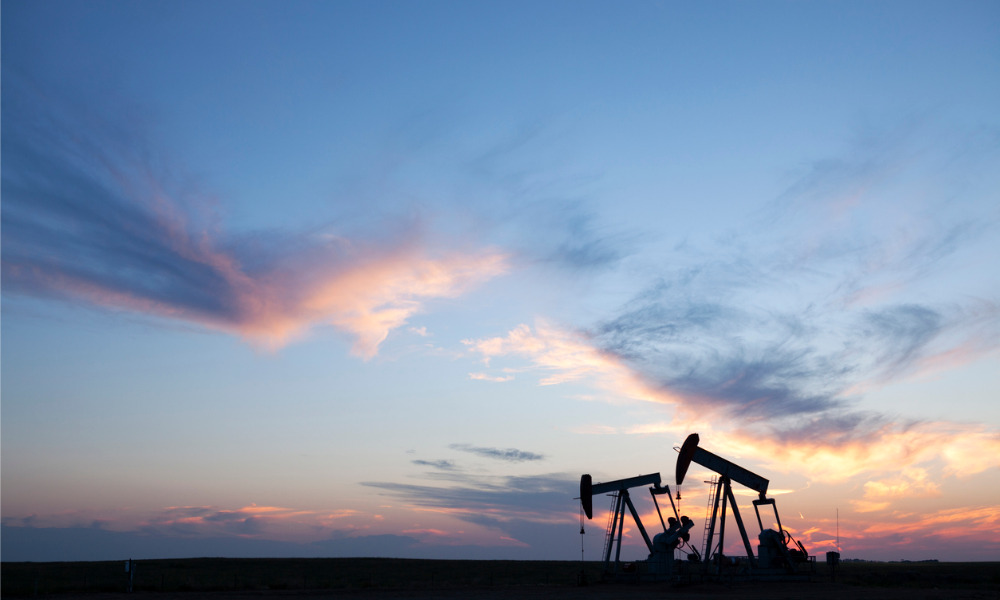The 2022 oil rally has not been like past booms.
Recovery from the COVID-induced demand dip and the Russian invasion of Ukraine helped push prices north. Though it has tapered off since, the cost of Western Canada Select rose 73.1 percent between June 2021 and June 2022, while the price of West Texas Intermediate climbed 60.2 percent over the same period, according to Alberta Energy and the US Energy Information Administration.
But despite the high prices, lawyers advising companies in the oil and gas sector say they are not seeing the industry reinvest these gains in further production, directing it instead toward share buybacks and dividends. Producers are also investing in technology and processes focusing on emissions reduction.
“We’re not seeing that money go back into the ground in ways that, I think, may have happened in earlier bust-and-then-boom cycles,” says Simon Baines, a partner in the energy group at Osler Hoskin & Harcourt LLP’s Calgary office. “Boom times come around, [and] oftentimes the oil and gas companies couldn’t get the money back into the ground fast enough to produce more oil and gas. We’re really not seeing that in the same way.”
“Even though everything is very profitable right now, there’s still a lot of headwinds facing the traditional oil and gas industry,” says Xiaodi Jin, a partner at Borden Ladner Gervais LLP in Calgary who advises companies in the oil and gas sector. “I think companies are just very cautious about what to do, what the future holds, and how to spend their money and time.”
On top of uncertainty about future prices and the future policy outlook, the sector is also at capacity for services and skilled labour, adds Jin, who focuses on M&A, securities and corporate finance, structuring, and governance.
“Companies are buying back shares and companies are doing acquisitions,” he says. “Some companies are just doing one-off dividends.”
According to Baines, capital investment has also been on the wane for several years, even before the pandemic’s demand destruction.
“A lot of people, myself included, have been expecting there to be difficulties on the supply side,” he says. “I think we’re now really seeing that, and obviously exacerbated by the war in Ukraine, but I don’t think really caused by the war in Ukraine.”
“Issues around the supply side of the industry have been coming for a number of years now. And with the demand rebounding coming out of the pandemic, I think we were already going to see a tightening of markets.”
With climate change and rising interest rates potentially causing a medium-to-long-term decline in demand, oil and gas companies are thinking twice about major capital investments, says Ron Ezekiel, co-leader of Fasken’s global energy and climate group in Vancouver. He sees some investment, particularly in gas, though. These companies are looking to take advantage of the market rebound and explore new opportunities, such as the export market where North American natural gas can displace coal and other more carbon-intensive generation in Asia.
According to the International Energy Agency, Canadian natural gas has room to grow as much of the international community turns away from Russia, the world’s second-largest natural gas producer. Russia’s invasion of Ukraine is helping prices rebound and is also providing export opportunities for natural gas, says Ezekiel.
“It’s breathing some new life and new opportunities into the sector,” he says. There is a “revival of interest in LNG projects on both coasts. Even the West Coast sees some interest because greater demand means some LNG volumes or cargoes will be diverted elsewhere.”
In 2018, Shell, PETRONAS, PetroChina, Mitsubishi Corporation, and KOGAS launched a joint venture to develop LNG Canada, an LNG processing and export facility in Kitimat, British Columbia. Currently 60 percent completed, the site will be able to produce 14 million tonnes of LNG annually.
“That should be coming online in 2024, and that’s going to be Canada’s first LNG export facility,” says Peter Danner, a partner in the oil and gas group in Torys LLP’s Calgary office. He says that LNG Canada and the potential of other projects are driving a lot of activity in the natural gas space.
On the other side of the Rockies, with the retirement of coal-fired electricity power plants, LNG will remain the backbone of the Alberta electricity grid for a long time, says Baines. The province has increased renewable energy generation – predominantly solar and wind. But absent significant technological developments around battery storage capacity, the sporadic nature of wind and solar makes it challenging for these sources to displace natural gas, he says.
“On a smaller geographic area like Alberta, it’s much harder, without batteries, to really cope with the intermittent nature of renewable resources,” says Baines. “You need something to backstop that, to make sure that the lights stay on even in the nighttime when the wind isn’t blowing.”
According to Danner, high commodity prices and their resulting optimism have created a lot of transactional work.
“The M&A space is very busy,” he says. When the pandemic hit, the collapse in oil prices slowed down deals for the balance of 2020. But beginning in 2021 and for the 18 months since, there has been a resurgence. Danner’s office has not yet seen a slowdown.
Several underlying trends drive the activity, he says. LNG growth is one. There are a lot of non-core asset divestitures, as companies focus on their core assets and use the divestment as an opportunity to return funds to shareholders. Danner is also seeing a lot of private equity sales.
“There’s a lot of private equity money that went into [upstream oil and gas], and when the oil prices collapsed, they were stuck with these assets that were difficult to sell. But now that the price has gone up, there’s a lot of private equity seeking to exit those investments. That’s driving activity.”
Read this article to know the types of asset that used in securitization and can be sold or traded.
ESG portfolio rebalancing is also stimulating M&A, he says. Larger oil and gas companies are divesting higher-carbon assets and consolidating positions to decarbonize their operations, putting those assets up for sale. Owners whose asset portfolios have more carbonization tolerance will then buy them.
High oil prices can also pose a challenge for M&A, says Baines. Whenever prices are on the extremely high or low end, there is a potential for diverging views on valuation between vendors and acquirers. Buyers may not be willing to pay the current peak price, assuming it will not last.
“When the prices are really volatile, or when they’re particularly high or particularly low, I think it can make it challenging to get deals done, and so there may be some of that going on,” he says. “That said, I think deals will continue to get done, but I’m not sure that I expect to see a raft of acquisitions in the current pricing environment.”
In the oil and gas sector, generally, there is a heightened focus on ESG, says Kevin Kerr, a partner in the Calgary office of Blake Cassels & Graydon LLP, who has a corporate/commercial, energy, and M&A practice. ESG has the industry’s executives and boards incorporating closer attention to the environmental and social aspects of the business into their development strategies. According to Kerr, this includes directing capital toward new technology and the technological upgrades that will bolster their emissions-reduction abilities.
The Pathways Alliance represents these efforts, he says. The organization comprises six companies representing 95 percent of Canada’s oil sands production: Canadian Natural, Cenovus Energy, ConocoPhillips Canada, Imperial Oil, MEG Energy, and Suncor Energy. The Pathways Alliance says it will achieve net zero carbon emissions by 2050 through carbon capture and storage, process improvements, electrification and fuel substitution, energy efficiency, and emerging technology, aided by partnerships with Ottawa and provincial governments.
While Kerr says Canadian producers have always been responsible for their development and environmental considerations, there has never been this level of capital spending on these programs. He says this shows that the sector is open to change and is looking to balance the competing demands of producing today’s required commodities while looking to find alternative energy sources.





